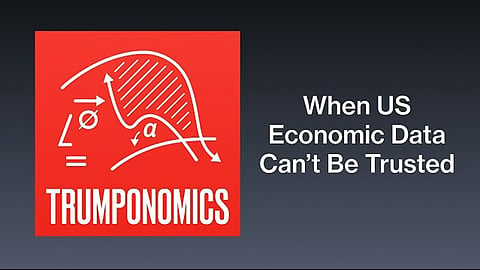

Adelaide | We may already live in the post-truth world, but are we about to enter the era of post-truth statistics?
Each month, the US employment report is one of the most closely watched releases on the health of the world's largest economy. Financial markets can move sharply depending on the strength of the numbers.
This month, the jobs report was weak. Hours later, US President Donald Trump called the numbers “phony” and fired the head of the agency, Erika McEntarfer.
It was an unprecedented attack on the government's impartial statistics body, the Bureau of Labour Statistics. This is the agency responsible for tracking jobs, wages and inflation – key numbers that tell us how the economy is really doing.
Trump followed that up this week with a further attack on the nation's economic institutions. He claimed in a social post he had fired one of the governors of the US central bank, the Federal Reserve. The governor, Lisa Cook, said he had no authority to do so.
With Donald Trump's war on numbers and long-standing institutions, can we even trust US economic data anymore? Some players in financial markets are already looking at alternative sources of data to get a real-time read on the health of the economy – such as satellite images of the shadows cast by oil tankers.
Chipping away at independence
On the surface, replacing the head of the Bureau of Labour Statistics (BLS) with a Trump loyalist might not sound like a big deal. But a BLS commissioner cannot single-handedly falsify the data. The agency is large, full of professional staff, and its data is processed through established systems and checks.
However, the issue goes far beyond firing one official. The Trump administration has taken a series of steps that chip away at the quality and independence of America's economic data.
After firing McEntarfer, Trump then appointed a loyalist who floated the idea of not releasing the jobs data at all.
The employment report is one of the most closely watched indicators of the US economy, showing how many jobs are being created or lost each month. Without it, millions of Americans would lose a vital tool for understanding whether the economy is growing, slowing, or heading into trouble.
Data is disappearing – literally
Hundreds of US datasets and more than 8,000 government webpages have vanished because the staff maintaining them were fired. These datasets, which taxpayers funded and researchers rely on, are now endangered.
In fact, academics have launched the Data Rescue Project to preserve and share this data publicly when the government stops doing so.
Critical economic statistics agencies — the Bureau of Labour Statistics is just one of several — have cut staff. This shrinkage makes their data less precise, because fewer staff means fewer surveys, slower updates, and more reliance on estimates.
But here's the irony: now the administration is attacking and even firing officials on the grounds that the data is unreliable, when that unreliability is the direct result of their own budget cuts. It's a political catch-22: gut the agency, then blame it for the very decline in quality that underfunding caused.
The Fed relies on this report to set interest rates Data is a public good, which means many benefit from it, yet data users are often unable or unwilling to pay for it. This is why data on labour market, inflation or economic growth (gross domestic product) is collected and published by the government, and paid for with taxpayers' money.
Good quality data enables good policy decisions. For example, the BLS jobs report and inflation numbers are studied carefully by the Federal Reserve to set US interest rates.
The consumer price index (CPI) – a widely watched inflation index – is a benchmark for the US central bank's mandate to keep inflation at its 2 per cent target. So the quality of the CPI sets the floor for the quality of interest rate decisions.
Financial markets, too, watch government data closely. Both US stock and bond markets, worth trillions of dollars, move sharply on jobs and inflation releases.
Some traders are sourcing their own data Sophisticated institutional traders such as hedge funds have long profited from having access to higher-quality data.
For example, some hedge funds use satellite images of Walmart parking lots to count the number of cars, which helps predict quarterly sales. This allows them to make money from the insights before Walmart's sales data becomes public.
Can these alternative data sources also help assess the strength of parts of the economy? A recent academic paper investigates whether private satellite data can be a substitute for official data.
Focusing on two specific measures – US crude oil price, and Chinese manufacturing – the paper finds satellite data is so commonly used by traders that markets no longer react to government data releases, such as weekly surveys of crude oil inventories.
However, there are two caveats. First, not every type of macroeconomic data underpins trillion dollar markets like crude oil, making it profitable for traders to analyse the geometry of shadows cast by floating roofs of oil tankers, estimating quantities of oil stored in these tanks.
Second, this data is only available to a few deep-pocketed investors prepared to pay for it. For most market participants, purchasing satellite-imagery data from companies like Privateer or RS Metrics is prohibitively expensive. This creates inequities in data access and undermines market fairness.
The technological advancements in AI and commercialisation of space make satellite data ubiquitous. But this data is still years away from replacing hand-collected inflation numbers or labour market surveys, which generate public statistics for everyone, not just for those who are prepared to pay.
